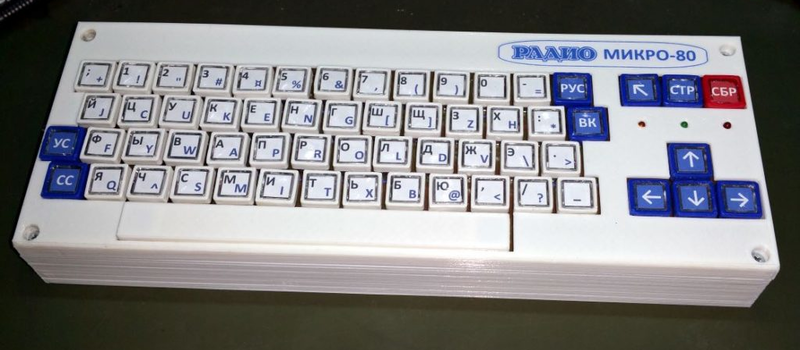[Alex Zaikin] made a modern reproduction of an early-80s Soviet hobbyist home computer. Although the design was open, indeed it was published in “Radio” magazine, the project was a mammoth undertaking involving around 200 microchips, so not many “Mikro-80” computers were actually made.
[Alex] wanted to simplify the project and reduce the parts count. These days, 200 microchips’ worth of logic can easily fit inside an FPGA, and [Alex] wrangled the chip count down to seven. Moreover, he made it even easier to build your own retro minicomputer by building a modular platform: Retrobyte.
With the Retrobyte providing all of the essential infrastructure — SD card, tape recorder I/O, VGA outputs, and more — and the FPGA providing the brains, all that was left was to design a period keyboard and 3D print a nice enclosure. Project complete! Time for a few rounds of ASCII Tetris to celebrate.
We’ve covered a number of retro computer projects. We just have a soft spot for them, is all. If you don’t know what all the fuss is about, you could start out with a kit build to get your feet wet. Before long, you’ll be emulating ever obscurer computers of yore in custom logic. And when you do, be sure to drop us a line!


















Nice build, FPGA and 3D printed retro computer, everything old and new again. Also one question, is “JCUKE” a standard Russian keyboard or just unique to the MNKPO-80? (I know I got the N wrong too, I just don’t know the code for Russian “I”.)
https://en.wikipedia.org/wiki/JCUKEN
Modern Russian keyboard has a standard QWERTY for latin letters, but cyrillic alphabet is arranged as ЙЦУКЕН. So, for clarity: Q – Й, W – Ц, E – У, R – К, T – Е, Y – Н.
There’s a link to the reverse engineering of the Soviet 8080 clone, to make the HDL model used here. 3 days of acid etching!
https://habrahabr.ru/post/249613/
Also – The original Mikro-80 design rebuilt, with 200 chips:
https://commons.wikimedia.org/wiki/File:%D0%A1%D0%BE%D0%B1%D1%80%D0%B0%D0%BD%D0%BD%D1%8B%D0%B9_%D0%BF%D0%BA_%D0%9C%D0%B8%D0%BA%D1%80%D0%BE-80.jpg
There’s a relatively recent rebuild of it at
http://vlad6502.livejournal.com/11796.html
(or http://vlad6502.livejournal.com/tag/%D0%9C%D0%B8%D0%BA%D1%80%D0%BE-80)
“it took only 34 hours . Another fun statistics – from the beginning of the project spent 75 meter wire MGTF and 100 grams of solder”
Via this thread:http://zx-pk.ru/threads/17142-sborka-mikro-80.html?p=710578&viewfull=1#post710578
Oops, pasted a bad link. Try this:
https://commons.wikimedia.org/wiki/File:%D0%A1%D0%BE%D0%B1%D1%80%D0%B0%D0%BD%D0%BD%D1%8B%D0%B9_%D0%BF%D0%BA_%D0%9C%D0%B8%D0%BA%D1%80%D0%BE-80.jpg
Wow! Thanks for those links. That’s some great stuff.
It’s a Cyrillic alphabet. It’s like all the buttons on a calculator that you never use…
“buttons on a calculator that you never use”
That’s like being proud of being illiterate.
My reaction on opening the original android calculator app for the first time..
http://4.bp.blogspot.com/_24bBhuX5Evg/TTfxDGUilZI/AAAAAAAAACg/jXvQQszWvPE/s1600/android-calculator.png
Was, “OMG, that’s practically neanderthal! “
I use an HP-48 or 49 emulator on the phone, as I used the physical device during university.
But it’s kind of like how a touch scree qwerty keyboard isn’t all that useful to a touch typist.
What do you mean illiterate? If your a math savant the buttons you never use on a calculator are all of them!
Meh, I could only ever be bothered memorising pi to 5 decimals.
How I wish I could calculate pi…
PI ,just DMA from my brain 3.14159265359
I always wondered about the operating systems/bios from the radio magazine computers, did the magazine supply a disk or something?
I doubt it, maybe a tape. A home-built computer’s difficult enough, building a floppy drive is pretty much impossible. At least, one aligned to be able to read other people’s disks.
I’d guess they printed a few K of hex and you’d have to type it in. Maybe they’d send EPROMs mail order. That’s the way things were done in the West back then.
They just printed it in the magazine. Including BASIC. As far as I know, this computer never had floppy drive connected.
Indeed they were printing pages and pages of hex code.
Yes, and sometimes it took hours to enter. I remember spending hours entering hex only to find the code was larger than what would fit on tape so I have to write a very small compression routine in the remaining RAM to save the day.
Something like that: http://malykh.com/img/2015-11/16-URLh50NWmKs-Mk-Q-aYlsSdzYc8/2015-11-16_230619.png
Was there ever a version of BASIC, or other language, where keywords were in Russian?
No. It has pretty much standard version of BASIC. I’ve run some programs on this computer (C, PASCAL, FORTH etc) and all of them use standard commands too.
Thanks Alex. Interestingly, I only found few esoteric programming languages in languages other than English so far.
Well that’s very interesting because all the early versions of BASIC that I saw used one byte tokens to represent BASIC keywords so it would have been very easy to do.
Perhaps the issue is that you need to change the character set as well???
Most of the character generators were in English or Japanese and couldn’t be altered.
Though you get some weirdness where yes original program used the one byte tokens, but you export the listing as something ASCII-ish and and then reload it from the ASCII backup, or from a listing you got from someone else, and it recognises the keywords, but they aren’t retokenised… So one byte per character on return…
What I mean is that more might have to be changed to recognise the non-tokenised keywords. Rather than it just being a display option.
Bending my head round that on a Sharp PC-1403 at the moment, since RAM is highly limited and only apparent way to backup and restore programs results in loss of tokenisation. So you could write something, say a hundred lines average 50 bytes a line, have it fit in RAM, ~5kB, then save and restore and suddenly it’s over 6kB.
COMAL for the Atlacatl Home Computer(very late 70s, early 80s, El Salvador, 6502, 9928/9927, SN76489, stock 48k up to 1MB, very unknown micro) used commands in Spanish
But most most people used BASIC on it, which was standard 6502 BASIC in English.
Horosho
Why Calibri? WHY? :O